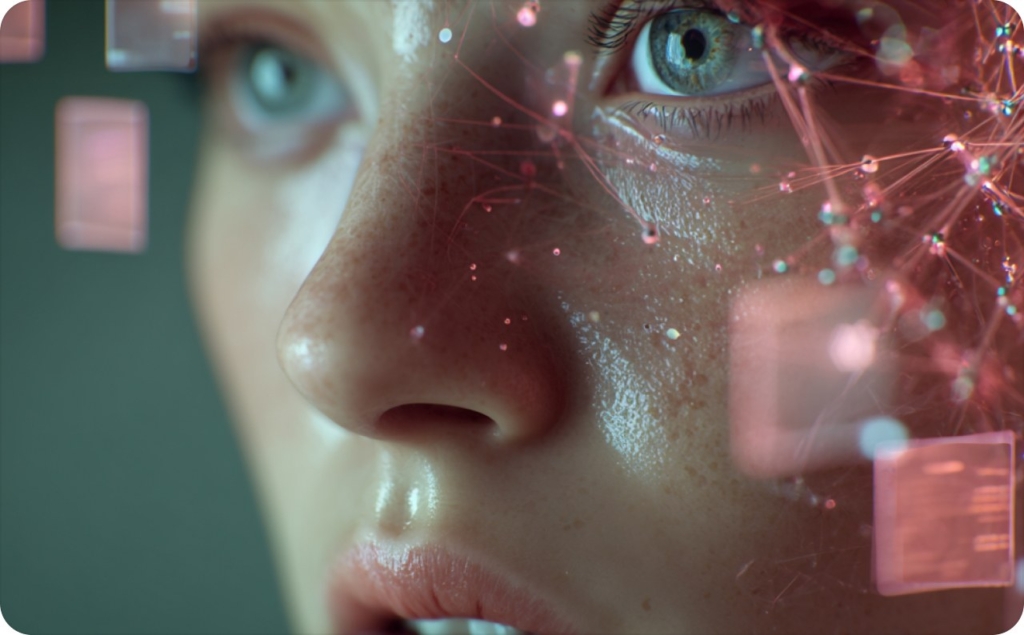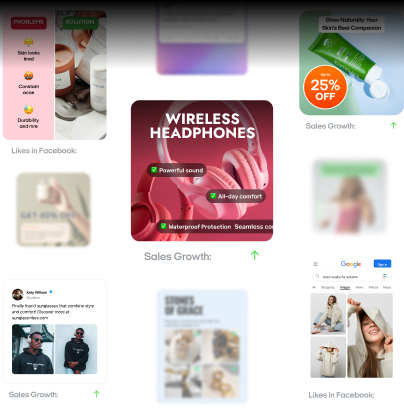What is AI UGC: 3 reasons why marketers use it to boost ROI
Wonder how AI-generated UGC is changing digital marketing? Zeely AI explores what AI UGC is and shares three powerful reasons why marketers use it to boost engagement and ROI.
Does your content feel expensive, slow, and inconsistent to create? Traditional user-generated content once soared on organic posts, but modern marketers need high-volume, on-demand content that still feels personal and authentic.
That’s where AI UGC steps in. It uses machine learning and natural language processing to mimic the tone, style, and appeal of real UGC. You’ll reduce costs, speed production, and ensure consistent messaging across channels. 43% of professional marketers claim they use generative AI in content creation.
In this guide, you’ll learn how AI UGC compares to traditional UGC and how to use it ethically. We’ll also cover the tools and workflows that streamline production without sacrificing authenticity. Embrace a faster, more scalable content strategy. Let’s explore how AI UGC can keep you ahead of the curve.

Understanding the basics
User‑generated content has reshaped modern marketing, turning everyday voices into powerful brand assets. It began with simple posts and photos taken by everyday people. Today, it’s a powerful way to build trust, loyalty, and genuine connections — if you know how to use it effectively.
What is traditional UGC
If you’ve ever read a real customer’s review, you’ve seen traditional user-generated content. It’s created by everyday people, not marketing teams. That’s why it feels genuine and nurtures brand trust.
Early platforms like MySpace and Facebook fueled this grassroots effect, uniting communities around candid opinions. Yet unpredictability and uneven quality can slow your marketing efforts. People still love these authentic voices, but waiting for the next post isn’t always practical.
That’s where AI-augmented approaches step in. They build on UGC’s strengths while solving major hurdles, so you keep that real feel while scaling and streamlining your content. With AI UGC creators, you can produce UGC-style posts faster, test different angles, and fill content gaps without losing the raw authenticity fans expect.
Defining AI UGC
Unlike traditional user-generated content, which relies on people posting reviews or photos, AI UGC is on-demand. By the AI UGC definition, it’s user-driven marketing using AI to create posts that feel authentic. This change happened as brands sought faster ways to create realistic assets, particularly as AI technology advanced.
In practice, AI‑generated content functions as automated user content. Algorithms analyze huge data sets, then produce text, images, or videos that match your brand’s tone.
The result of such content is faster output, lower costs, and greater flexibility. A beauty brand might compare AI-led testimonials against real user reviews, measuring engagement and click-throughs to see how closely AI content mirrors genuine voices.
Labeling AI-driven posts or clarifying their origin helps maintain trust. Because AI depends on data patterns rather than lived experience, it’s crucial to address authenticity concerns. Still, AI UGC offers efficiency, scalability, and innovation, providing a reliable flow of content with the raw appeal of real voices.
How AI is revolutionizing UGC
AI is changing user-generated content in big ways. Instead of waiting for real users, you can produce consistent, brand-friendly posts in minutes. It’s fast, scalable, and can still feel real to your audience and create viral video ads with AI in 15 minutes.
Speed and scalability
Traditional user-generated content can be powerful, but it’s often slow. You rely on your audience, hoping they’ll post reviews or videos right when you need them. That unpredictability makes it hard to scale fast. That’s why more brands lean on AI for rapid, on-demand UGC-style content that still feels authentic.
Cost efficiency and resource optimization
AI systems use machine learning and your brand guidelines to generate testimonial scripts or TikTok captions. Imagine you need 20 new user stories for a product launch. A human team might spend days on this. An AI tool can produce all 20 in a few hours, with the right voice and format.
You want to save money without compromising content quality. That’s where AI-generated user content comes in. A March 2023 survey shows that 84% of U.S. content creators use generative AI to lower production costs. They especially use it for repetitive tasks like scripting testimonials or editing short-form videos.
AI UGC also helps you scale user-style content. Think product reviews, unboxing scripts, or behind-the-scenes snippets. You don’t lose your brand voice or audience engagement in the process. This blend of cost efficiency and authentic storytelling makes AI-driven UGC a smart choice for marketers.
Enhancing authenticity and engagement
First, you get consistent throughput. You’re not waiting on user availability or juggling freelancer schedules. You also gain rapid testing. Try multiple tones, like “real talk,” “before-and-after,” or “unboxing delight”, and see what resonates. You’ll also save on manual labor, freeing up funds for promotion or creative strategy.
Speed, though, shouldn’t mean going hands-off. Successful brands still review and refine AI-generated posts to keep them human.
Start with 10 AI-driven testimonials, then compare engagement, saves, and shares against real UGC. If the results hold up, you have a scalable way to boost your UGC strategy without sacrificing authenticity.
Key takeaways
10× faster output
20 AI-made testimonial posts produced in hours, not days
84% adoption
Most creators already use generative AI to slash production costs vs. traditional shoots
Same-day A/B
Run ten AI testimonials beside real UGC in one afternoon to spot top-engagement tones
How to create AI UGC with Zeely AI
Even with so many AI advertising tools available, it’s not easy to find one that truly fits your needs. Some focus only on static ads, while others specialize in video. And those that try to do it all often come with a price tag that’s tough for small businesses.
That’s where Zeely AI UGC video ad creator comes in. It’s a versatile solution designed for entrepreneurs and small businesses to drive traffic using AI-powered video and static ads.
With Zeely, you can launch and track campaigns, run A/B tests, and stay cost-efficient — all without design skills, copywriting experience, or a marketing background.
Smart AI automation works hand in hand with expert-level marketing logic to deliver high-performing creatives. You can use Zeely on iOS, Android, or tap into even more features on the web version.
Process overview and best practices
If you run an online store, just paste your product link. Zeely will automatically pull in the product’s name, price, description, and images. If you don’t have a website, add product details manually.
Create UGC-style video ads
Click + New Video in the Videos section and pick a product. Choose from Zeely’s high-converting templates. Next, select one of 30+ hyper-realistic AI avatars of different looks and voices — all with lip-sync tech for lifelike speech. Pick one that matches your audience.
Then, choose a video script for your avatar to say. Zeely’s AI writes it using proven marketing formulas like AIDA, PAS, Problem-Solution, and Three Reasons Why. Finally, add background music that fits the mood of your ad. After that, hit Render, and your video will be ready in about 12 minutes.
Generate high-converting static ads
While you’re waiting for the videos to render, you can generate static ads. Click + New static ad and choose your product. Then, pick one of the 100+ proven & tested winning ad templates to build your ad creative.
The AI will quickly generate high-converting ad copy. If you don’t like the first option, you can ask an AI-rewrite or edit it manually. You don’t have to be a copywriter or designer to make static ads — it’s all AI-powered.

Launch AI-powered campaigns
Finally, you can launch your ads on Facebook, Instagram, or TikTok. You should use both Meta platforms, so AI can distribute traffic based on how users behave, not on assumptions. Pick at least three materials for the campaign: 1 video and 2 static ads. It’s better for A/B testing and using results for future campaigns.
Track and optimize
After launching a campaign, you’ll have to wait for Meta to review it. With Zeely, it takes 1–6 hours, compared to the usual 24 hours. After your campaign ends, check the data-driven insights. If you find an ad that works well, use it again in your next campaign, changing the copy and design as needed.
Challenges, ethics, and the future of AI UGC
AI UGC opens up exciting possibilities. But it also raises new questions about trust, fairness, and the future of user-generated content. Brands must handle issues like bias and transparency to stay genuine and build a better tomorrow.
Ethical considerations and transparency
AI-generated user content can boost your marketing, but it also raises tough ethical concerns. If you don’t label AI-made posts, you might mislead your audience and weaken trust.
Some AI models also risk bias. They learn from skewed data and can exclude key voices. Plus, reusing images or text without a license may violate copyright.
To stay ethical, label AI-driven content and schedule audits to spot bias or unlicensed assets. Review your brand voice and gather feedback from your community.
FTC rules and other guidelines are changing. Track evolving policies if you target global markets. Finally, keep a human touch. A quick review ensures each post fits your tone and avoids insensitive language.
When you approach AI UGC with transparency and responsibility, you build trust instead of hurting it. Ethical choices here can become a brand advantage, not just a risk management tactic.
Hybrid approaches: Blending AI and human-generated content
You don’t have to lose authenticity for speed. Hybrid AI UGC lets you combine fast automation with genuine human touches. AI handles repetitive tasks. Real creators handle emotion, brand voice, and inclusivity. You should always label AI output and regularly review data for bias to keep your content transparent.
Hybrid strategies are essential: they merge AI with human creativity. AI drafts at scale, then humans adjust tone and cultural nuances. For instance, let AI write ten social posts for a launch, and have your team or brand fans personalize them. This approach prevents off-brand phrasing and cuts production time.
Start with AI for bulk ideas, but review each output for empathy and inclusivity. If the content feels robotic or biased, fix or scrap it. You can even invite users to provide prompts, ensuring your AI hits real pain points. Track not just likes but also clicks or sign-ups. Compare hybrid posts with purely human ones to see what resonates.
Future trends in AI-generated content
We’re witnessing a surge in AI-driven content, from AR/VR integration to hyper-personalization. A recent report predicts AR-based shopping will rise sharply by 2025. It’s proof that transformative AI tools can boost engagement.
Next-Gen AI content and hyper-personalization
As AI evolves, you can serve content that updates on the fly. Tools like Marketo or Mailchimp with AI add-ons automatically tailor emails and offers based on real-time data. This adaptive approach ensures each user sees messaging that reflects past actions, boosting relevance and impact.
Bridging AR/VR and hyper-personalization
Immersive AR/VR experiences are enhanced by advanced AI that tracks user responses and emotional reactions. Picture a VR showroom shifting scenes if it detects excitement or frustration. Keep storytelling human by combining automation and empathy. That way, your brand voice remains vibrant, not robotic.
How can marketers adopt these AI-driven solutions:
- Start small. Launch a 360° VR pilot: track dwell time, clicks, or sign-ups for real insights
- Invest in analytics. Gather detailed user data. Feed it into hyper-personalization systems to refine offers in real time
- Maintain a human touch. Check AI outputs for brand tone, empathy, and cultural awareness. If something feels off, revise or discard it
By tapping into AR/VR, hyper-personalization, and predictive digital marketing, you’ll create interactive content that not only grabs attention but also drives measurable results.
Conclusion
AI UGC offers faster production, deeper personalization, and a stronger digital transformation. Combining machine learning with user-style content can help you appeal to modern audiences without losing authenticity. Run a pilot campaign, label AI outputs, and get real feedback.
Track metrics like engagement and conversions. If it feels off-brand or biased, refine or pivot. Explore tools for hyper-personalization or predictive digital marketing. Revisit case studies for ethical labeling and blending human edits.
Ultimately, getting started with AI UGC means you experiment, gather data, and stay flexible. With each step, you shape a future-ready content strategy that balances efficiency with genuine connection.
Also recommended



